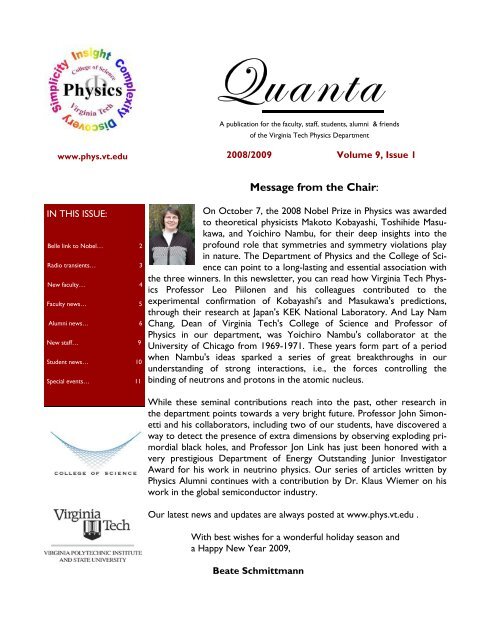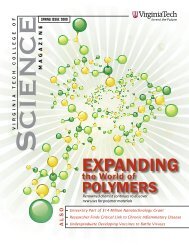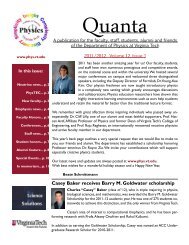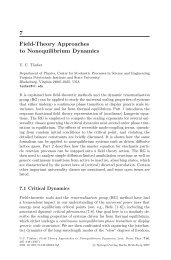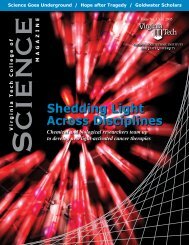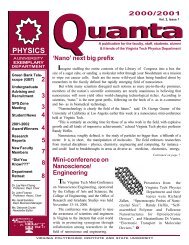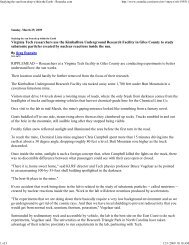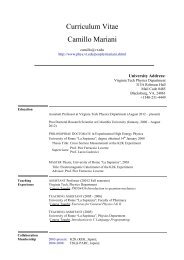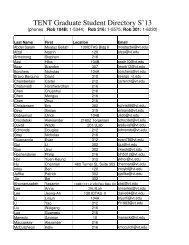Fall 2008 - Physics - Virginia Tech
Fall 2008 - Physics - Virginia Tech
Fall 2008 - Physics - Virginia Tech
You also want an ePaper? Increase the reach of your titles
YUMPU automatically turns print PDFs into web optimized ePapers that Google loves.
dâtÇàt<br />
A publication for the faculty, staff, students, alumni & friends<br />
of the <strong>Virginia</strong> <strong>Tech</strong> <strong>Physics</strong> Department<br />
www.phys.vt.edu<br />
<strong>2008</strong>/2009 Volume 9, Issue 1<br />
Message from the Chair:<br />
IN THIS ISSUE:<br />
Belle link to Nobel… 2<br />
Radio transients… 3<br />
New faculty… 4<br />
Faculty news… 5<br />
Alumni news… 6<br />
New staff… 9<br />
Student news… 10<br />
Special events… 11<br />
On October 7, the <strong>2008</strong> Nobel Prize in <strong>Physics</strong> was awarded<br />
to theoretical physicists Makoto Kobayashi, Toshihide Masukawa,<br />
and Yoichiro Nambu, for their deep insights into the<br />
profound role that symmetries and symmetry violations play<br />
in nature. The Department of <strong>Physics</strong> and the College of Science<br />
can point to a long-lasting and essential association with<br />
the three winners. In this newsletter, you can read how <strong>Virginia</strong> <strong>Tech</strong> <strong>Physics</strong><br />
Professor Leo Piilonen and his colleagues contributed to the<br />
experimental confirmation of Kobayashi's and Masukawa's predictions,<br />
through their research at Japan's KEK National Laboratory. And Lay Nam<br />
Chang, Dean of <strong>Virginia</strong> <strong>Tech</strong>'s College of Science and Professor of<br />
<strong>Physics</strong> in our department, was Yoichiro Nambu's collaborator at the<br />
University of Chicago from 1969-1971. These years form part of a period<br />
when Nambu's ideas sparked a series of great breakthroughs in our<br />
understanding of strong interactions, i.e., the forces controlling the<br />
binding of neutrons and protons in the atomic nucleus.<br />
While these seminal contributions reach into the past, other research in<br />
the department points towards a very bright future. Professor John Simonetti<br />
and his collaborators, including two of our students, have discovered a<br />
way to detect the presence of extra dimensions by observing exploding primordial<br />
black holes, and Professor Jon Link has just been honored with a<br />
very prestigious Department of Energy Outstanding Junior Investigator<br />
Award for his work in neutrino physics. Our series of articles written by<br />
<strong>Physics</strong> Alumni continues with a contribution by Dr. Klaus Wiemer on his<br />
work in the global semiconductor industry.<br />
Our latest news and updates are always posted at www.phys.vt.edu .<br />
With best wishes for a wonderful holiday season and<br />
a Happy New Year 2009,<br />
Beate Schmittmann
Page 2 Faculty News<br />
Quanta, <strong>Fall</strong> <strong>2008</strong><br />
Nobel Prize winners theory validated by Belle research findings<br />
By: Prof. Leo Piilonen<br />
<strong>Virginia</strong> <strong>Tech</strong> played an important role in the<br />
research that led to the recently announced<br />
<strong>2008</strong> Nobel Prize for <strong>Physics</strong>. Half of the<br />
prize was awarded to theorists Makoto Kobayashi<br />
and Toshihide Masukawa, with the<br />
other half going to Yoichiro Nambu.<br />
The Belle facility in 1999<br />
The Nobel Committee's citation of Kobayashi<br />
and Masukawa's work specifically references<br />
the validation of their predictions by<br />
the Belle experiment. We in Belle are very<br />
happy to see their seminal work recognized<br />
at long last by the Nobel Committee.<br />
Kobayashi and Masukawa's research, dating to 1972, showed how a broken symmetry of nature, first<br />
observed in the 1960's in the decays of subatomic particles known as neutral kaons, led to the prediction<br />
of three families of quarks as well as the expectation that this symmetry breaking would also be<br />
visible in the decays of the particles in the hitherto-unseen third family.<br />
Their theory was validated conclusively in 2001 by measurements performed<br />
by the Belle experiment, a detector at the High Energy Accelerator<br />
Research Organization ("KEK") in Japan. <strong>Virginia</strong> <strong>Tech</strong> faculty members<br />
Al Abashian (emeritus), Kazuo Gotow (emeritus), and Leo Piilonen<br />
were among the founding members of the Belle experiment in the early<br />
1990's and, along with their postdoctoral associates and students, played<br />
key roles in its original conception, construction, operation, and data<br />
analysis that led to this successful validation.<br />
The Belle collaboration, formed in 1993, now includes about 400 scientists<br />
from 11 countries, and continues its research in subatomic physics<br />
to elucidate the behavior of matter at its most elementary level. In one<br />
aspect of this research, the predictions of Kobayashi and Masukawa are<br />
measured and confirmed with ever more exquisite precision. Ironically,<br />
Leo Piilonen as more data is collected by the Belle detector, the hope is that small but<br />
significant deviations from Kobayashi and Masukawa's prediction will<br />
appear, thus leading to better insight into broken symmetry in nature.
Page 3<br />
Search for radio transients may reveal extra dimension<br />
Article provided by Prof. John Simonetti<br />
<strong>Physics</strong> Professor John Simonetti is conducting a search for radio transients from the cosmos, in collaboration<br />
with faculty members of the Electrical and Computer Engineering Department, Steven Ellingson<br />
and Cameron Patterson, and graduate students in both departments. Radio transients, or isolated<br />
bursts of radio emission from extraterrestrial sources, would be signatures of explosive highenergy<br />
events in the universe. Such events can signal a range of exotic phenomena, including supernovae,<br />
coalescing compact objects (e.g, neutron stars), and the explosions of primordial black holes.<br />
Typically, radio astronomers point one<br />
large-dish telescope, or a set of telescopes,<br />
at a single object (e.g., a radio<br />
galaxy) for hours or days to obtain high<br />
quality images of structure within the<br />
object, in order to understand its<br />
The antennas forming the ETA<br />
physical nature. But to detect isolated, unpredictable explosive events in the universe, the <strong>Virginia</strong><br />
<strong>Tech</strong> group literally casts a wide net using an array of simple dipole antennas tuned to longwavelength<br />
radio waves. Their instrument, built in North Carolina, is called the Eight-meterwavelength<br />
Transient Array (ETA). The array can detect bursts from any direction above the horizon.<br />
Large amounts of raw data are collected continuously. In one mode of operation about 200<br />
gigabytes of data are collected per dipole, per hour. There are 20 dipoles in the original ETA array,<br />
with a second array in the construction stages. After collection, this data is searched for the proverbial<br />
“needle in a haystack” --- an arriving radio burst.<br />
Bursts of particular interest to the group would be produced by evaporating primordial black holes,<br />
remnants of the Big Bang. If there is a tiny, coiled-up, extra spatial dimension in the universe, in addition<br />
to the three large-scale dimensions we can easily experience, a primordial black hole explosion<br />
can signal the existence of the extra dimension. This explosion occurs when an evaporating black<br />
hole shrinks to the size of the extra dimension. At that point the black hole would undergo a topological<br />
transition, from a “donut” stretched around the extra dimension, to a “sphere” inside the extra<br />
dimension, emitting some fraction of its mass in an explosive event. ETA can detect such an<br />
event, and distinguish it from other explosions.<br />
The details were worked out by Simonetti and graduate student Michael Kavic. “One day Mike came<br />
running down the hall, shouting ‘Look at this! Look at this!’ while waving a reference he had found<br />
that suggested such an event was possible,” said Simonetti. They worked tirelessly over the next few<br />
months to put together the details. The detection of a radio pulse from a black hole undergoing this<br />
phase-transition explosion would signal the existence of an extra dimension of about 10 −20 to 10 −18 m<br />
in size. Extra dimensions of similar size are also being searched for at the Large Hadron Collider.<br />
A draft paper describing this work is available at http://arxiv.org/abs/0801.4023. When this draft first<br />
appeared it made a splash in Nature News (http://www.nature.com/news/<strong>2008</strong>/080201/full/<br />
news.<strong>2008</strong>.549.html), New Scientist magazine (08 February <strong>2008</strong>, page 19), and other publications.<br />
An updated version will appear soon in the Journal of Cosmology and Astroparticle <strong>Physics</strong>.
Page 4 Quanta, <strong>Fall</strong> <strong>2008</strong><br />
New Faculty<br />
Nahum Arav arrived<br />
in January <strong>2008</strong><br />
from the University of<br />
Colorado Boulder<br />
where he was a research<br />
professor, and<br />
assumed an associate<br />
professor position at<br />
the VT physics department.<br />
Nahum received<br />
his PhD from the University of Colorado<br />
Boulder and afterwards spent several<br />
years at Caltech and UC Berkeley. His field<br />
of research is astrophysics and he is using<br />
the Hubble space telescope and the largest<br />
ground based telescopes to study the influence<br />
of super-massive black holes on cosmological<br />
structure formation. His research<br />
group here includes one senior scientist<br />
(Manuel Bautista) one postdoc (Jay Dunn),<br />
one graduate student (Doug Edmonds) and<br />
several undergrad research assistants. Nahum<br />
is very keen on general education and<br />
public outreach activities.<br />
Patrick Huber graduated<br />
from the <strong>Tech</strong>nische Universität<br />
München (TUM), Germany<br />
in 2003. His thesis<br />
won him a coveted recognition,<br />
namely, the Otto-Hahn<br />
Medal of the Max Planck Society.<br />
He spent one more<br />
year at the TUM as a postdoctoral<br />
fellow before moving<br />
to the University of Wisconsin<br />
at Madison, where he spent three years as a<br />
research associate. In 2007, Patrick moved to<br />
CERN to join the Theory group as a fellow. He<br />
joined the Department of <strong>Physics</strong> at <strong>Virginia</strong> <strong>Tech</strong> in<br />
August <strong>2008</strong>. His hobbies include playing LEGO<br />
with his two kids, as well as cooking.<br />
Seong Ki Mun joined the department in the fall of <strong>2008</strong> as a professor<br />
and research fellow in the National Capitol Region. Prior to joining <strong>Virginia</strong><br />
<strong>Tech</strong>, Dr. Mun served as professor of radiology and of immunology, as well<br />
as director of the Imaging Science and Information System (ISIS) Research<br />
Center, at Georgetown University Medical Center. As Associate Vice President<br />
there, he was responsible for congressional programs and developing<br />
research projects in oncology, neurosurgical surgery, biodefense, and drug<br />
development. His research deals with diagnostic imaging, chronic illness<br />
management, home monitoring, telemedicine, disease surveillance, surgical<br />
instrumentation, robotics for casualty assessment, and cancer therapy. In<br />
the early 1980s, he led the development of one of the first 1.5T high field<br />
whole body MRI systems at Columbia University Medical Center in New<br />
York City. In his spare time, Dr. Mun enjoys golfing.
Page 5<br />
Vice Versa: Matt Joyce<br />
Matt as an incoming freshman<br />
Demonstrating jet propulsion<br />
What happens when the student suddenly becomes the teacher?<br />
It sounds like the plot of a Disney comedy, but for instructor<br />
Matt Joyce, it is a reality. Matt received his undergraduate degree<br />
from our department in 2005 and his Master’s degree in December<br />
2007. This fall, he began teaching Foundations of <strong>Physics</strong>.<br />
His former professors are now his colleagues, and he is grateful<br />
for their advice. “Everyone has been extremely helpful whenever I<br />
have a question about anything,” says Matt. When asked what he<br />
would have done differently as an undergrad, Matt responded, “I<br />
would have asked more questions in class.” He is now using that<br />
insight to engage the next generation of students. In the classroom,<br />
he likes to make questions that the students can relate to,<br />
like those relating to velociraptors and Star Wars. He also likes to<br />
use demos and get students involved using the iclicker technology,<br />
an audience response system that allows teachers to interactively<br />
poll students to measure their knowledge during class.<br />
In Short...<br />
♦ Royce Zia was recognized as VT Scholar of the Week (January 1-7, <strong>2008</strong>).<br />
♦<br />
♦<br />
♦<br />
♦<br />
Roger Chang received the <strong>2008</strong> Faculty Appreciation Day Students’ Choice Award for Faculty<br />
Member of the Year.<br />
Tatsu Takeuchi contributed a section of Theory of Neutrinos: A White Paper, which was selected<br />
as one of the Reports on Progress in <strong>Physics</strong> Highlights of 2007.<br />
Uwe Täuber was recognized as an “Outstanding Referee” by the American Physical Society.<br />
Guy Indebetouw was recognized as VT Scholar of the Week (April 21-27, <strong>2008</strong>). Guy retired in<br />
August, after 30 years of service for <strong>Virginia</strong> <strong>Tech</strong>. An article in our next newsletter will honor his<br />
many contributions to the department.
Page 6 Alumni News Quanta, <strong>Fall</strong> <strong>2008</strong><br />
In Their Own Words: Dr. Klaus Wiemer, Class of ‘69<br />
Dr. Wiemer delivers a speech before the Prime Minster<br />
of Taiwan and others at the grand opening of<br />
the Taiwan Semiconductor Manufacturing facility<br />
There were seven of us receiving PhDs<br />
in physics in June of 1969. Dr. James Jacobs, the<br />
department chair, was delighted that at least<br />
one of us had accepted a job in industry.<br />
“There should be more like you”, he exclaimed,<br />
“providing scientists to industry is an important<br />
part of our mission”. At graduation I had a job<br />
offer in hand from Texas Instruments Inc. (TI)<br />
in Dallas. With the invention of the silicon transistor<br />
and the integrated circuit (IC) to its credits<br />
and as the world’s #1 manufacturer of ICs at<br />
the time TI was my employer of choice. R&D<br />
emphasis in microelectronics matched my field<br />
of interest, solid-state physics or physics of<br />
condensed matter.<br />
On the other hand, the glassy looks in the<br />
eyes of my audience after concluding a presentation of my dissertation On the Dielectric Response of<br />
Real Solids in Many-Body Perturbation Theory, which I gave as part of the job interview, suggested that if<br />
hired I would have to be very flexible and willing to learn new things rapidly. Very few PhDs hired by<br />
industry had the “luxury” to working on anything resembling their graduate research. During the first<br />
few years I worked on three-dimensional heat transfer problems for the design of heat sinks, did<br />
range statistics for high-energy ions fired into silicon wafers and invented processes for synthesis of<br />
useful compounds in low-density plasmas. Peer recognition, if at all, came only after you have patented<br />
your ideas or after they have lost their commercial value and you could talk about them. What<br />
an advanced degree does provide, however, is opportunity. Having demonstrated the ability to work<br />
independently and creatively as a student, opens up the possibility early in your industrial career to<br />
manage your own project and to receive the credit for your work. This is extremely important if one<br />
is to avoid a Dilbert scenario.<br />
<strong>Tech</strong>nical accomplishments in technology driven companies may lead to promotions; if this<br />
happens, you pick up management skills as you go. While at TI I became quite good at manufacturing<br />
the chips which form the building blocks of all things electronic and I wound up constructing and operating<br />
many of the factories which turn polished silicon wafers into arrays of IC chips. IC manufacturing<br />
is probably the most demanding, unforgiving and capital intensive manufacturing process. During<br />
the heady growth years of 70s, 80s and 90s demand for these manufacturing skills was quite high<br />
and after fifteen years I left TI to become my own boss as a consultant in Europe and the US assisting<br />
companies to improve their IC manufacturing operations. In 1987 one of my former TI bosses recruited<br />
me to Taiwan to become Chief Operating Officer and President of the world’s first contract<br />
chip manufacturing company. This was a new type of business; until then, IC companies considered<br />
chip manufacturing technologies their highly proprietary crown jewels. It was primarily the increasing
Page 7<br />
“Wiemer” continued<br />
cost of these plants – an economy-of-scale operation today requires a capital investment of more<br />
than three billion dollars – together with the off-the-shelf availability of IC design tools and the standardization<br />
of process technologies which made outsourcing of the chip manufacturing process possible<br />
and an attractive alternative for even the largest companies in the field. Today Taiwan Semiconductor<br />
Manufacturing Company (TSMC) is the world’s largest chip “foundry” with a 50% share of the<br />
world contract chip manufacturing market. After Taiwan I followed invitations by the Singapore government<br />
and the Malaysian state of Sarawak on the island of Borneo to build similar plants. These too<br />
are successful companies today. So, if today some in this country lament the outsourcing of hightechnology<br />
manufacturing jobs to SE Asia, I accept some of the “blame”. After 30 years working in<br />
many locations around the world, it would have been satisfying to end my factory building career with<br />
a meaningful project in my native country; unfortunately, a chip factory project which I started in 1999<br />
in the former East Germany, failed due to lack of timely funding and difficulties with the European Union<br />
bureaucracy.<br />
As an industrial career winds down, directorships<br />
offer an opportunity to stay connected with one’s field “What an advanced degree<br />
and former associates while leaving some time for fishing, does provide, however, is<br />
travel and serving on committees of your universities.<br />
And so, after many years of absence, I have started to return<br />
to the <strong>Tech</strong> campus. Whenever I do, I wish I were a<br />
opportunity.”<br />
student again. With what I know today, what advice would I give to students? After reading The Earth<br />
is Flat, that should be a no-brainer. Whatever career path you choose, pick one that lets you work<br />
and live anywhere in the world, wherever there is opportunity and excitement. I assure you that in<br />
terms of satisfaction and enjoyment few activities beat working and creating something useful where it<br />
is appreciated and rewarded while getting to know new people, languages and cultures.<br />
Alum competes in triathlon<br />
In late September <strong>2008</strong>, Alma Robinson (class of 2002)<br />
competed once more in the Naylor Beach triathlon in<br />
Warsaw, <strong>Virginia</strong>. The event consists of a 1.5 km swim, a<br />
40 km bike race, and a 10 km run. Alma finished third in<br />
her age group with a time of 2 hours and 49 minutes, shaving<br />
five minutes off of last year’s time. Her goal for the day<br />
was to not leave the race in an ambulance. She celebrated<br />
her success with “some food, a touch of champagne, and a<br />
trip to a pumpkin patch/farm on the way home.” Just like<br />
last year, Alma attributes her performance to carbo-loading<br />
on pasta the night before and consuming quantities of caffeine<br />
the day of the race.
Page 8 Quanta, <strong>Fall</strong> <strong>2008</strong><br />
This and That<br />
♦ Jay Mettetal (class of 2003) recently received his Ph.D. in <strong>Physics</strong><br />
from Massachusetts Institute of <strong>Tech</strong>nology. He is currently working as a<br />
researcher for Pfizer in Cambridge, MA.<br />
♦ Pam Granger and Mary Ellen<br />
(Tremblay) Bowman (both from the class of<br />
2004) passed the bar exam last year.<br />
♦ Beth Reid and Burke Green (both from<br />
the class of 2003) married in June <strong>2008</strong>.<br />
Nicole and Nick ♦ John Janik (class of 2002) received his<br />
Ph.D. from Florida State University, He is now a<br />
fellow at the Carnegie Institute of Washington, where is working on<br />
growing large single-crystal diamonds.<br />
Beth and Burke<br />
♦<br />
Nicole Spencer and Nick Luhring (both from the class of 2007) married<br />
on May 24, <strong>2008</strong> in Cary, NC.<br />
“Faculty” continued from p. 5<br />
♦<br />
♦<br />
♦<br />
♦<br />
Jonathan Link received an Outstanding Junior Investigator award for his proposal titled Experimental<br />
Studies in Neutrino Masses and Mixing Angles. Nationwide, the Department of Energy<br />
awarded only ten of these highly competitive and prestigious grants this year.<br />
Michel Pleimling contributed a chapter to the book Rugged Free Energy Landscapes.<br />
Nahum Arav and a senior researcher in his group, Dr. Manuel Bautista, received approval of<br />
their Hubble Space Telescope (HST) proposals. Prof. Arav received a total of two and a half days<br />
of observing time on the telescope to measure chemical abundances around black holes situated<br />
about a billion light years away from us. A grant of $120,000-$150,000 will accompany this program.<br />
Dr. Bautista received $80,000 of funding to create spectral models of singly-ionized ironpeak<br />
species for HST science. The prestigious HST program is very competitive, with an over subscription<br />
rate of about seven.<br />
Leo Piilonen was interviewed by the CBS affiliate WDBJ7 on September 11, <strong>2008</strong>, the day after<br />
the Large Hadron Collider in Geneva generated its first beam. Asked whether the experiment<br />
could create black holes and lead to doomsday, Leo Piilonen said that it's not all that risky. The<br />
full interview can be found at http://www.wdbj7.com/Global/story.asp?S=8995138
New Staff Page 9<br />
New Staff<br />
Tammy Harris has been<br />
with the department since<br />
February <strong>2008</strong> as a Program<br />
Support <strong>Tech</strong>nician.<br />
Outside of work she enjoys<br />
spending time with her<br />
family and friends, traveling,<br />
and has found a new love for yoga and meditation.<br />
She is currently pursuing a certification in<br />
Massage Therapy.<br />
Jo Ellen Narron graduated<br />
from <strong>Virginia</strong> <strong>Tech</strong> in<br />
May <strong>2008</strong> with a B.S. in<br />
<strong>Physics</strong>. She continues to<br />
work with Prof. Jonathan<br />
Link on the Daya Bay neutrino<br />
experiment. In her<br />
spare time, Jo Ellen is an avid amateur photographer.<br />
Tina Lawrence joined the<br />
<strong>Physics</strong> Department in December<br />
2007 as the Fiscal<br />
<strong>Tech</strong>nician. She brings to<br />
the department over fifteen<br />
years of accounting experience.<br />
Her job duties include<br />
financial budgeting/support, analysis, reconciliations,<br />
and purchasing. She greatly enjoys reading,<br />
NASCAR racing and watching her daughter<br />
play fast pitch softball.<br />
Lisa Stables, the new<br />
<strong>Physics</strong> Business Manager,<br />
has twenty-one years of<br />
professional experience,<br />
including eleven years of<br />
experience working with<br />
<strong>Virginia</strong> <strong>Tech</strong> university<br />
administrative, human resources, and financial<br />
procedures. She most recently served for ten<br />
years as the department head’s assistant in<br />
the Department of Mechanical Engineering,<br />
and previously worked for one year in the<br />
<strong>Virginia</strong> <strong>Tech</strong> Foundation accounting office.<br />
Lisa is the proud mother of a sixteen-yearold<br />
son and an eight-year-old daughter. In her<br />
spare time, she enjoys spending time with her<br />
family, crafts, and searching for antiques with<br />
particular interest in vintage glassware and<br />
toys.
Page 10 Students News Quanta, <strong>Fall</strong> <strong>2008</strong><br />
Honors and Accolades<br />
♦<br />
♦<br />
Michael Kavic won the Best Student Presentation award at the 11th East Coast Gravity Meeting.<br />
Chris Knorowski co-authored an article published in the Journal of Chemical <strong>Physics</strong>.<br />
Kevin Finelli received the highly competitive Barry M. Goldwater Scholarship for<br />
the <strong>2008</strong>-09 academic year. Kevin is a member of the Society of <strong>Physics</strong> Students and<br />
Sigma Pi Sigma. He has participated in research in both the Departments of <strong>Physics</strong><br />
and of Mathematics at <strong>Virginia</strong> <strong>Tech</strong>, as well as the Jefferson National Laboratory in<br />
Newport News, <strong>Virginia</strong>. Kevin is <strong>Virginia</strong> <strong>Tech</strong>’s 37th Goldwater Scholar, and the<br />
8th from <strong>Physics</strong>.<br />
Juliette Mammei was one of eight recipients of the <strong>2008</strong> Jefferson Sciences<br />
Associates Graduate Fellowship. She was also awarded the Luise Meyer-<br />
Schutzmeister Memorial Award, presented annually to an outstanding woman<br />
graduate student in physics. Juliette works with Prof. Mark Pitt on the Qweak<br />
and G0 experiments. She and her husband Russell (also a graduate student in<br />
our department) welcomed their first son Ethan in May <strong>2008</strong>.<br />
The <strong>2008</strong> departmental awards ceremony was held at<br />
the Graduate Life Center on Friday, April 8. A record<br />
number of awards were given to thirty-six students.<br />
This year marked the inaugural awarding of the Dr.<br />
James A. Jacobs Memorial Graduate Fellowship, established<br />
in honor of a former professor who served as<br />
department chair for thirteen years. Breaking from tradition,<br />
there was no keynote speaker at this year’s ceremony. Instead, after the awards were given,<br />
guests were encouraged to attend the first Sowers Distinguished Lecture presented by Dr. Joseph<br />
Polchinski, renowned professor of physics at UC-Santa Barbara.
Special Events Page 11<br />
What’s Happening?<br />
The Department of <strong>Physics</strong>, in conjunction with the College of<br />
Science, held its first “Fun with <strong>Physics</strong>” event at the Northern<br />
<strong>Virginia</strong> Center on February 10, <strong>2008</strong>. The free, public event<br />
included hands-on demonstrations conducted by members of<br />
the <strong>Physics</strong> Outreach Team, as well as a talk titled Life in the<br />
Universe by Prof. John Simonetti. The department hopes to host<br />
similar events in the future. Nearly 200 physics enthusiasts of<br />
all ages attended. “Fun With <strong>Physics</strong>” was a joint effort of the<br />
<strong>Physics</strong> Department and the College of Science. A special<br />
thanks goes to Karen Akers, the director of the Northern <strong>Virginia</strong><br />
Center, who helped coordinate the event .<br />
Another informal alumni event accompanied the March Meeting of the American Physical Society in<br />
New Orleans this year. Current Hokies, alumni and friends mingled at a local café to catch up on happenings<br />
in everyone’s lives.<br />
The next March Meeting will take place in Pittsburgh, PA. If you plan to attend or if you live in the<br />
Pittsburgh area, please keep the evening of March 17, 2009, open. We will announce the location of<br />
our get-together early next year.<br />
On May 14-16, <strong>2008</strong>, the Department of <strong>Physics</strong> hosted an international symposium titled Complexity<br />
in Materials Far from Equilibrium. Eleven invited speakers presented research on topics ranging from<br />
driven systems to physical aging. The symposium also consisted of poster sessions and contributed<br />
talks, including one from alum David Adams (class of 2007).<br />
dâtÇàt ECCK<br />
Editor: Betty J. Wilkins .<br />
Additional editing, content, and design: Beate Schmittmann,<br />
Chris Thomas, Diane Walker-Green<br />
Contributors: Nahum Arav, Tammy Harris, Patrick Huber, Matt<br />
Joyce, Tina Lawrence, Seong K. Mun, Jo Ellen Narron, Leo Piilonen,<br />
Alma Robinson, John Simonetti, Lisa Stables, Klaus Wiemer
The <strong>Physics</strong> Department Annual Fund<br />
<strong>Virginia</strong> <strong>Tech</strong> is currently running a major fundraising campaign - The Campaign for <strong>Virginia</strong><br />
<strong>Tech</strong>: Invent the Future. In parallel, the Department of <strong>Physics</strong> is strengthening the national<br />
and international reputation of its research and educational programs. With excellence in<br />
nanoscience, complex systems, and neutrino physics, the department is already targeting areas<br />
of nationally recognized importance. By strengthening these efforts and expanding them towards<br />
biological and medical problems on the one hand, and astrophysics and cosmology on<br />
the other hand, we will position the department at the leading edge of scientific discovery for<br />
many years into the future. We will continue to set high standards of excellence in undergraduate<br />
and graduate education, focused on fundamental principles and emerging frontiers.<br />
Your support will be critical for our success. When you receive your College of Science Annual<br />
Fund letter or phone call, please earmark your support for the <strong>Physics</strong> Department.<br />
Simply make a notation on the gift card or let the caller know that you want to direct your<br />
donation to the <strong>Physics</strong> Department. You can also visit our website, http://www.phys.vt.edu/<br />
giving.html, or give us a call at (540) 231-7472. We thank you in advance for your support.<br />
When you contribute to physics, you contribute to the future.


